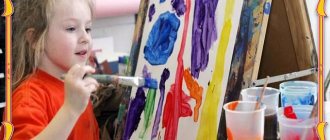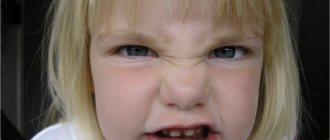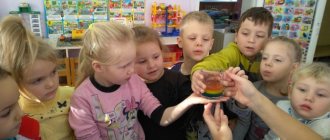Definition of the concept of environmental education
Environmental education is the inculcation of moral categories that are responsible for developing a caring attitude towards the environment in a person.
Environmental education should begin from preschool age, since it is at this moment that a person develops a set of basic moral values. Note 1
As part of environmental education, the child becomes familiar with the basic concepts of nature, realizes that he is part of this nature, and that people are responsible for almost everything that happens on our planet. The child must learn to take care of the environment. These goals and objectives are precisely realized within the framework of environmental education.
Are you an expert in this subject area? We invite you to become the author of the Directory Working Conditions
Variety of effective forms of work
The teacher’s repertoire should include not only traditional forms of working with children; it is replenished depending on the teacher’s experience and his creative searches. Environmental education of preschool children in the institution is implemented through the following activities:
- Game-activity. This type of organized activity is the leading one in a child’s life, and therefore is widely planned for all ages of preschoolers. Work on environmental education of children can be carried out during role-playing games: “Seed Store”, “Vegetable Store”, “People’s Pharmacy”, “Nursery”, “River Watch”, “Pet Store”, “Veterinary Pharmacy”.
- Spectacular events. Ecological entertainment, holidays according to the seasons, contribute to the emotional perception of information, the motivation to preserve the wealth of nature of the native land. Such events include: “Praise to Bread”, “Harvest Festival”, “Autumn Extravaganza”, “Crystal Winter-Winter”, “The Rooks have Arrived”, “Hello, Red Summer!”. The production of the musical “How the Animals Prepared for Winter” and the opera “Ball of Flowers” promote imaginative perception and easy assimilation of the material.
- Working with family. To teach parents the concept of “ecology for kids,” you can hold open days, environmental events, hiking trips, travel, and Kindness Days.
- Cooperation with society. The program for environmental education of preschoolers provides for continuity in the work of a preschool institution and the primary level of a comprehensive school. To form the foundations of environmental culture among preschoolers and schoolchildren, it is possible to organize forums for the exchange of children’s experiences, “Young Researcher” competitions, laboratories “Advice of the scientist Probirkin”, workshops “Lessons of Samodelkin”, and a club “Lessons of Environmental Safety”.
- An excursion to the nursery will help children understand the painstaking work of adults in the process of growing plants from small cuttings into large garden crops. To visit a shelter for homeless animals with your children together with their parents means to awaken in the pupils a feeling of deep compassion for abandoned pets, a desire to take care of them and help them find their owner.
- Work. The teacher implements the objectives of the program in practical activities at the site, in the environmental center, and at thematic sites.
- The production of homemade books “Ecological Tales” in the joint activity of children with their parents will make it possible to intensify the children’s mental activity in inventing a plot and designing book pages. Children are invited to design books such as: “The Tale of the Curious Kozyavochka”, “How the Droplet Traveled”, “The Tale of the Sundew Flower”. Workshop for making dolls “Droplet”, “Queen Ecology”, “Probirkin”, “Samodelkin”, “Environmental Safety” Such books will enrich development centers with new characters who will become the main characters of the kids’ games, their advisers in making smart decisions in preserving the environment of their plot.
Forms of environmental education
There are the following forms of environmental education:
- educational activities
- excursions
- themed holidays
- getting to know nature in everyday life
- work activity
- exhibitions, competitions, olympiads
Educational activities are the leading method of introducing students to nature and the surrounding world. In the process of educational activities, the teacher systematically provides knowledge about natural phenomena and objects to children, taking into account their age, psychological characteristics and the specifics of the area in which the children live.
Classes can have several varieties:
- introductory lessons
- generalizing lessons
- in-depth educational lessons
During introductory lessons, students can become familiar with different species of animals, plants and natural phenomena that are not found in their area. During the lesson, the teacher uses a large number of visual aids. They help students develop correct ideas about the topic of the lesson.
Finished works on a similar topic
Course work Methods and forms of environmental education 420 ₽ Abstract Methods and forms of environmental education 230 ₽ Examination Methods and forms of environmental education 230 ₽
Receive completed work or specialist advice on your educational project Find out the cost
During a generalization lesson, children learn to generalize their knowledge regarding certain natural phenomena and objects. During this lesson, children learn to analyze, compare, and generalize.
During an in-depth cognitive lesson, children expand their knowledge of the phenomena that they see every day in everyday life. The teacher supplements the existing information with new information.
Excursions occupy a special place in the process of environmental education. During excursion lessons, children can get acquainted with natural phenomena in a natural setting. It is advisable to conduct excursions to the same places at different times of the year so that children can notice seasonal natural changes.
Themed holidays are very interesting for children and adults. They can be dedicated to a certain time of year, natural phenomena, animals, etc. The peculiarity of this form of work is that children develop a positive response to it in their consciousness.
In a preschool institution, during daily walks, the teacher introduces children to natural phenomena and materials, for example, children play in the sand, with snow, and with fallen leaves.
Labor activity occupies a special place in the process of environmental education. Labor activity is exciting for children; it can take place in the garden, vegetable garden or flower garden. Children can plant seeds, water plants, remove weeds, and harvest crops. Any work activity instills in children a love of work and independence, and in the process of environmental education, in addition, there is the formation of responsibility for the surrounding nature.
Children can take part in various competitions and quizzes, where they can demonstrate their knowledge about objects and natural phenomena, and children can also make crafts from natural materials.
Theory and methodology of environmental education; methodological development on the topic
Features of environmental education of preschool children.
Currently, the problem of environmental education is relevant. In modern society, environmental consciousness has not been formed. To solve this problem, the Ministry of Education of the Russian Federation requires that the formation of environmental knowledge in preschoolers be included in the educational process, starting from a young age.
Environmental education in preschool age is primarily aimed at developing the child’s humane feelings and accumulating emotionally positive experiences with nature.
Environmental education for preschoolers involves creating a system of work in kindergarten that would become an interesting, exciting process for both children and adults.
Ecology is the science of the interactions of living organisms with each other and the environment.
Environmental education is the formation of a consciously correct attitude of children towards an object of nature. It is advisable to engage in environmental education of children from the first years of life.
Environmental education includes intellectual, emotional, aesthetic and effective aspects. All three aspects are interconnected and form a moral basis, which is manifested in the child’s behavior.
Environmental education of a child involves:
- Fostering a humane attitude towards nature (moral education);
- Formation of a system of environmental knowledge and ideas (intellectual development);
- Development of aesthetic feelings (the ability to see and feel the beauty of nature, admire it, the desire to preserve it);
- Participation of children in activities feasible for them to care for plants and animals.
A child’s consciously correct attitude towards nature is based on basic knowledge of an ecological nature.
Ecological knowledge is information about the relationship of specific plants and animals with their environment, about their adaptability to it.
The process of introducing children to environmental culture occurs from early preschool age. As a rule, all areas of preschool childhood play a fundamental role in the environmental education of a child: family, peers, various types of educational institutions. The influence of a preschool institution on the formation of environmental knowledge can be decisive.
The environment, its proper organization in a preschool educational institution and the skillful inclusion of the child in active interaction with the surrounding objective and natural world are one of the conditions for the effectiveness of the formation of environmental knowledge in a preschool institution. The effective influence of the environment on the personality of a child in a preschool educational institution largely depends on the ability of teachers to organize such an environment.
The experience of many educators at Russian preschool educational institutions shows that in the process of environmental education and upbringing of preschool children, it is necessary to form a structure of holistic knowledge about the unity of earth, air, flora and fauna, the relationship and interdependence of man with the natural world.
For environmental education in preschool educational institutions, the following conditions are necessary:
- creating a corner of living and inanimate nature in the group;
- creation of external natural areas on the territory of the preschool institution - garden, vegetable garden, ecological trail, recreation area, “bird canteen”, etc.;
- interaction with parents to integrate environmental education with family education;
- organization of research and environmental activities of children based on a combination of feasible child labor with play situations.
This form of organizing children's research and environmental activities solves the problem of developing in children an understanding of the interconnections of all living and nonliving things in nature.
The objectives of environmental education are:
- developing children's skills and abilities to care for plants and animals;
- education of children’s sensory-emotional reactions to the environment;
- nurturing in children a caring attitude towards nature through targeted communication with the environment;
- education of aesthetic and patriotic feelings by means of nature.
Currently, there are a number of environmental programs for preschool educational institutions. Most of them are based on the formation in preschoolers of a cognitive attitude towards nature, labor skills and abilities, an understanding of the meaning of work as an activity to satisfy the needs of living beings; on cultivating an interest in work and nature, a careful and caring attitude towards nature, a humane and active attitude towards all living things; on the development of an ecological and aesthetic vision of nature, an aesthetic attitude towards it; to educate environmentally appropriate behavior in nature.
When working with children to develop an environmental culture, it is important to know the following principles of environmental education and education of preschool children:
- the principle of the developing and educational nature of knowledge about nature (the selection of knowledge about nature should be made taking into account the goals and objectives of environmental education of preschool children, their age capabilities);
- the principle of scientificity in the selection of knowledge content. It is necessary to proceed from the leading goals of modern natural science (the idea of the diversity of nature, the unity of the living and the nonliving, the relationship between the organism and the environment, the adaptability of the living to the conditions of existence, the variability of nature, the essence of the interaction between man and nature) and scientific concepts (plants and animals - living beings; living and inanimate; growth and development; biocenosis, etc.);
- the principle of encyclopedicity in the selection of knowledge content;
- the principle of taking into account the systematic character of knowledge about nature at different age stages;
- principle of accessibility;
- local history principle in the selection of material;
- ecological approach to the selection of knowledge about nature;
- the principle of concentricity in the presentation and assimilation of natural history knowledge in preschool age (complicating the material from group to group).
An important feature in the environmental education of preschool children is the organization of an ecological-developmental environment, which should contribute to the emergence and development of the child’s cognitive interests, the development of his volitional qualities, emotions and feelings, and promote interpenetration with the child’s natural environment.
When organizing the ecological and developmental environment, it is necessary to take into account:
- requirements for the selection and placement of plants and animals of a corner of nature in accordance with their biological characteristics;
- the ability to maintain objects in conditions close to natural;
- age characteristics of children (originality of perception, level of development and cognitive activity, accessibility for observation and work);
- safety of objects for the life and health of children, didactic and educational significance, etc.
When organizing work on environmental education of preschoolers, it is necessary to take into account the following methods:
- Observation is the leading method of environmental education for children. Observation enriches sensory experience, forms realistic ideas and concepts about nature, the foundations of ecological consciousness, an aesthetic vision of the natural world, a careful and caring attitude towards all living things.
- The use of illustrative and visual material in environmental education of children.
- The use of technical teaching aids (slides, filmstrips, films, videos, computer programs, etc.) in the system of environmental and pedagogical work.
- Labor as one of the main methods of environmental education for children.
- The use of elementary experiments in the system of environmental work with preschool children.
- Game as a method of environmental education.
- Modeling activity as a method of environmental education for children.
- The teacher's stories about objects and phenomena of nature, human activity in it.
- Compilation of a natural history book, its use to motivate the development of environmental concepts, in cultivating in children observation, interest, love and respect for nature, in enriching aesthetic impressions and feelings.
- The use of environmental fairy tales in the formation of a scientific vision of nature, in the disclosure of complex phenomena, the variety of forms of adaptation of living organisms to the environment, and the education of value orientations in relation to natural objects.
- Using conversations as a method of expanding, deepening, generalizing and systematizing children's knowledge about nature.
Questions for an interview with an ecologist (educator-specialist) of a preschool educational institution.
- What do you understand by the term “ecology”?
- What do you understand by the term “environmental education”?
- What do you understand by the term “ecological knowledge”?
- How do you understand what the goal of environmental education for preschool children is?
- What role do you think the formation of children’s emotional attitude towards nature plays in environmental education?
- Name what forms, methods and means should be used in the formation of environmental education of children.
- List what conditions need to be created in a preschool educational institution for the implementation of environmental education for children?
- What problems does environmental education of preschool children in preschool educational institutions solve?
- Name what three types of groups existing environmental programs can be divided into according to their content, goals and objectives.
- What requirements should a teacher take into account when organizing an ecological and developmental environment?
- Name the technical means that can be successfully used in the system of environmental and pedagogical work in preschool educational institutions?
Analysis of environmental education programs for preschool children.
Currently, there are a number of environmental programs for preschool educational institutions. An analysis of existing programs in terms of content, goals and objectives allows us to conditionally divide them into three main groups: environmental (mainly bioecological) programs; aesthetic, cultural and environmental programs; social and environmental programs.
Environmental programs (bioecological)
| Name | author | Purpose, objectives, content |
| "Young ecologist" | S.N. Nikolaeva | The program highlights two aspects of the content of environmental education: the transfer of environmental knowledge and its transformation into attitude. The author emphasizes that environmental education is associated with the science of ecology and its various branches. It is based on “leading ideas of ecology adapted for preschool age: the organism and the environment, the community of living organisms and the environment, man and the environment.” The program consists of two subprograms: “Environmental education of preschool children” and “Advanced training for preschool educational institutions employees.” The program is approved by the Federal Expert Council on General Education. |
| "We" | N.N.Kondratieva | The basis of the content of the program is “knowledge about man in his connection with nature, other people, ideas about man and nature as the highest values, knowledge about a humane attitude towards living things and the ability to implement it.” In this case, the main attention is paid to the consideration of the connections of living organisms with the environment at different levels. Each section of the program presents knowledge as the basis of environmental awareness, skills in environmentally oriented activities, and experience of a humane attitude towards nature. The basis of an individual’s ecological culture, according to the author, is the idea of the unity of man and nature. |
| “Our home is nature” | N.A.Ryzhova | The goal of the program is to educate from the first years of life a humane, socially active, creative personality, capable of understanding and loving the world around us, nature and treating them with care. Particular attention is paid to the formation of a holistic view of nature and man’s place in it. Children form their first ideas about the relationships that exist in nature and, on this basis, the beginnings of an ecological worldview and culture, a responsible attitude towards the environment and their health. Much attention is paid to the development in children of elementary ideas about the relationships existing in nature. Preschoolers learn to understand how closely natural components are interconnected and how living organisms depend on their environment. Man is seen as an integral part of nature. This approach makes it possible to bring children to a basic understanding of the problem of the relationship between man and the environment and the consequences of human activities. The moral aspect is of great importance. Children also acquire initial skills that allow them to participate in feasible practical activities to protect the nature of their native land. The program is recommended by the Ministry of Education of the Russian Federation. |
| "Ecological path" | A.V.Koroleva | The author of the program emphasizes that in the process of mastering its program, children receive basic concepts of ecology, master basic observation techniques in nature, master ethical standards of attitude towards living things, learn to understand and appreciate the beauty of living nature as a source of creative inspiration. |
| "I'm exploring the world" | Creative team of kindergarten No. 232 in Ulyanovsk, edited by E.E. Barannikova | The goal of the program is to help the child develop an elementary system of knowledge about nature, teach him to understand and establish the connections and dependencies that exist in it, and act in accordance with the knowledge acquired. |
| "Cobweb" | Zh.L. Vasyakina-Novikov | Formation of an integral system of knowledge and skills that develop planetary thinking in children based on the formation of a socio-ecological ideal; environmental education. The program includes four blocks: “How I live”; "Where I live"; "When I live"; “Who I Live With” and is organized by age group. Recommendations for the program have been issued, a specific technology for solving environmental education problems has been developed, and an approximate distribution of material for the year is presented. the program is recommended by the Ministry of Education of the Russian Federation. |
Aesthetic-cultural-ecological programs
| Name | authors | Purpose, objectives, content |
| "Semitsvetik" | V.I.Ashikova, S.G.Ashikova | The program is aimed at the cultural and environmental education of children, the development in them of the principles of spirituality, a rich, creative, self-developing personality. The authors believe that a child will learn to think and feel the natural world around him, how he will perceive the values of world culture, depends on how he acts, what actions he performs. The program involves joint creative activity of children and adults in kindergarten, children's studios or in the family. The basis of the program is the perception of beauty in nature, in man-made creations and in man himself, in his inner world and creative actions. The program has two basic themes: “Nature” and “Man”. The theme “Nature” includes not only its four kingdoms on Earth (minerals, plants, animals and humans), but also extends beyond the planet - into the near and far outer space. The second topic examines man - the creator of folk and national heroes, devotees of world culture, who entered the chronicles and left a good mark on the Earth. The authors identify the following thematic blocks: “Planet Earth”; "Sky"; "Art"; "Lights." The program is approved by the Ministry of Education of the Russian Federation. |
| "The world around us" | T.I.Popova | The program is defined as a “program of cultural-ecological education and moral education of children” and is an adaptation of the ideas of other programs of a similar type at the regional level. |
| "The planet is our home" | I.G. Belavina, N.G. Naidenskaya | One of the objectives of the program is “the formation of a new system of spiritual values of the child, based on the aesthetic components of the program.” |
| "Nature and the Artist" | T.A. Koptseva | The program is characterized by block-thematic planning: the blocks “Natural World”, “Animal World”, “Human World”, “World of Art” are highlighted. The author considers the natural world as a subject of close study and as a means of emotional and imaginative influence on the creative activity of children. Currently, this program is often used in combination with N.A. Ryzhova’s program “Our Home is Nature.” the program is approved by the Federal Expert Council on General Education. |
Social and environmental programs.
| "We are earthlings" | N.N.Veresova | The content of the program reflects a complex of socially oriented issues (social ecology, economics, civics, valeology, etc.). |
| "Economics and Ecology" | L.M. Clarina | The author notes that her developments are aimed at improving the economic, environmental and social consciousness of children. This author's program is intended for children aged 6 to 10 years, but its elements are used by a number of preschool institutions. The problems of economics and ecology are linked by the author through issues of the use of natural resources and an analysis of human needs. Many gardens use characters invented by the author - the Gnome Economy and the Ecology Fairy. |
| “Kindergarten of the XXI century” or “Nadezhda” | T.V.Potapova | In the program, along with issues of education in the field of the environment, much attention is paid to the formation of the child's fundamentals of citizenship, including familiarization with human rights, issues of rational environmental management (the full name of the program is a program for preparing preschool children to learn the basics of ecology, environmental management and human rights "). The author emphasizes that “when introducing a child to the world around him... the emphasis should be placed not so much on knowledge about objects and phenomena, but on the skills of careful and non-destructive handling of them and an active desire to act... in a gentle and conservation manner.” |
Literature
- System of environmental education in preschool educational institutions: information and methodological materials, greening of the developmental environment of a kindergarten, development of classes in the section “Natural World”, matinees, quizzes, games. – 2nd ed., stereotype. /aut.-state O.F.Gorbatenko.
- Dick N.F. Developmental lessons on ecology for preschoolers. – M.: LLC TID “Russkoe Slovo – RS”, 2006.
- Nikolaeva S.N. Methods of environmental education in kindergarten: Working with children in the environment. And Art. kindergarten groups: Book. for kindergarten teachers. – M.: Education, 1999.
- Kolomina N.V. Education of the fundamentals of ecological culture in kindergarten: Lesson scenarios. – M.: TC Sfera, 2005.
- Bondarenko T.M. Environmental activities with children 5-6 years old: A practical guide for educators and methodologists of preschool educational institutions. – Voronezh: TC “Teacher”, 2004.
about the author
Nikolaeva Svetlana Nikolaevna (b. 1940) – Doctor of Pedagogical Sciences, researcher in the field of environmental education, chief researcher at the Institute of Psychological and Pedagogical Problems of Childhood of the Russian Academy of Education.
She began her career as a teacher in one of the Moscow kindergartens. After graduating from Moscow State Pedagogical Institute. V.I. Lenina worked at the Research Institute of Preschool Education of the Academy of Pedagogical Sciences. She was a student of a prominent galaxy of domestic scientists: psychologists (V.S. Mukhina, A.V. Zaporozhets, N.N. Poddyakov, L.A. Wenger) and teachers (E.I. Zalkind, D.V. Mendzheritskaya, A.P. Usova , T. A. Markova, N. A. Vetlugina). Until 1979, she was engaged in research on the issues of mental education of preschoolers in the process of introducing them to nature. From 1980 to the present day, he has been engaged in research in the field of environmental education for preschool children.
S. N. Nikolaeva is the author of the first “Program of Environmental Education for Preschool Children” (1993), which later became the “Young Ecologist” program, and the first “Concept of Environmental Education for Preschool Children.” In 1992, a theoretical monograph “Communication with nature begins in childhood” was published, in which the author analyzes and summarizes research that made it possible to define a new – ecological – approach to introducing preschoolers to nature. From this moment the author’s intensive work in the field of environmental education begins. In 2006, S. N. Nikolaeva defended her thesis for Doctor of Pedagogical Sciences.
A contribution to preschool pedagogy is the author’s holistic system of environmental education for children from 2 to 7 years old in kindergarten and family settings, the theoretical justification of which is presented in this publication. The system defines the content and methods of environmental education for preschoolers, a program for preschool institutions, reveals the concept of “technology,” and presents a sequence of technologies for children of all age groups. Technologies for the “Young Ecologist” program allow practitioners to form the beginnings of an ecological culture in preschoolers. Adult education is also part of the system: the training of specialists in colleges and universities is carried out using the textbooks of S. N. Nikolaeva “Methods of environmental education of preschool children. Textbook for students of secondary pedagogical educational institutions" and "Theory and methods of environmental education for children. Tutorial. For students of preschool education faculties of higher pedagogical educational institutions." In the system of advanced training for preschool workers, the manual “Environmental education of children in preparation for school” is often used.
The sphere of today's scientific interests of S. N. Nikolaeva is the issues of comprehensive intellectual and personal development of children in the system of environmental education.
The effectiveness of pedagogical techniques and methods
Fostering an ecological culture among preschoolers implies variability in the methods and techniques of work in the presentation of educational material. They are divided into:
- conversations;
- observations;
- viewing objects;
- surprise moment;
- artistic word;
- dynamic pauses;
- finger gymnastics;
- method of projects, game learning situations.
Methods of environmental education of preschoolers today differ in many ways from outdated stereotypes; they are designed to combine into one whole the learning process and direct contact of a preschooler or primary school student with natural objects. Long-term projects are developed for older children and they are designed to implement the tasks of environmental education for children during one school year as part of the curriculum. The project involves a long process of observation, experimentation, followed by analysis of the effectiveness of the methods, techniques and forms of work with children used.
By the end of the project, older preschoolers will learn to make connections, draw parallels, see mistakes in activities, and learn ways to correct them. They will be able to compare the result of an experiment or an environmental project with the originally set task, and objectively comment on the result of the coincidence of their hypothesis with the data obtained. The guys will sum up the uselessness or effectiveness of their work and set themselves the task of reaching a new level. In middle-aged groups, such projects can last up to 1 month, in younger groups - 1 week.






